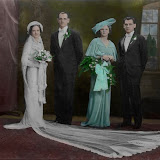Below is a compilation of some research I gathered from Michael Bauernfeind research in 1980 and from Bauernfeinds in Wisconsin.
The history is filled with Crusader knights, Catholic Church officials, including a bishop, crumbled castles, and numerous coats-of-arms. Wolfgang Mozart’s mother was a Salzberg Bauernfeind.
The family castles are no more than small, grass-covered heaps of stone. The families lost most of their titles. In the 1600s a Bauernfeind was beheaded for stealing a sheep. A painting of this event still hangs in a small village church in upper Bavaria. The painter gave our theif a saint’s halo.
Kemnater von Kemnat lived in his family castle Hohenkemnate located in the Upper Palatinate near Amberg, Bayern. This family served the Bohemian kings.
The Pauernfeind/Bauernfeind name surfaced by the 1400s. Their descendants served royal families in Prague. There were numerous great Bauernfeind Houses and castles. There is the impression that one Bauernfeind branch was too closely associated politically with the death of Jan Hus. During the Hussite Rebellion, the Bauernfeinds fled throughout Europe as religious refugees, specifically to Austria, Bayern, and the Tirol. At the time, they split into five branches, hoping that by traveling separately, they could more easily regain their titles, or earn new titles. Some did, however, the Arzberg branch became commoners, although an Arzberg Bauernfeind was knighted in the 1870s.
Overall, the Bauernfeinds were very determined people who welcomed challenges. Some were tall, but others were quite short.
When our ancestors traveled into the Byzantine, they were impressed by the more elegant culture there. So after returning home they adopted some of its practices and mannerisms. Hence, Bauernfeind, which translates roughly as ,,enemy of the peasant’s life style.
The Arzberg Bauernfeinds began to emigrate in 1842. Although, Arzberg, Bayern switched back and forth between Catholic and Lutheran several times, the Arzberg Bauernfeinds remained faithful Roman Catholics. Röthenberg, which is near Arzberg, however, is decidedly Lutheran. I suspect the Baltimore Bauernfeinds hail from Roethenbach.
Coming soon: a blog on Gustav Bauernfeind.




